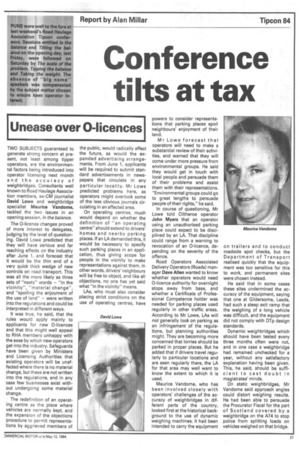Conference tilts at tax
Page 29

If you've noticed an error in this article please click here to report it so we can fix it.
IUnease over 0-licences I
TWO SUBJECTS guaranteed to generate strong concern at present, not least among tipper operators, are the environmental factors being introduced into operator licensing next month and the accuracy of weighbridges. Consultants well known to Road Haulage Association members, ex-CM journalist David Lowe and weighbridge specialist Maurice Vandome, tackled the two issues in an opening session, In the balance.
The 0-licence changes proved of more interest to delegates, judging by the level of questioning. David Lowe predicted that they will have serious and far reaching effects on the industry after June 1, and forecast that it would be the thin end of a very quick thick wedge of new controls on road transport. This was all the more likely as three sets of "nasty" words — "in the vicinity", "material change", and "spoiling the enjoyment of the use of land" — were written into the regulations and could be interpreted in different ways.
It was true, he said, that the rules would apply mainly to applicants for new 0-licences and that this might well appeal to RHA members unhappy with the ease by which new operators get into the industry. Safeguards have been given by Ministers and Licensing Authorities that existing operators will be unaffected where there is no material change, but these are not written into the regulations, and in any case few businesses exist without undergoing some material change.
The redefinition of an operating centre as the place where vehicles are normally kept, and the expansion of the objections procedure to permit representations by aggrieved members of the public, would radically affect the future, as would the expanded advertising arrangements. From June 1, applicants will be required to submit standard advertisements in newspapers that circulate in any particular locality. Mr Lowe predicted problems here, as operators might overlook some of the less obvious journals circulating in an affected area.
On operating centres, much would depend on whether the definition of "an operating centre" should extend to drivers' homes and nearby parking places. If an LA demanded this, it would be necessary to specify such parking places in an application, thus giving scope for people in the vicinity to make representations against them. In other words, drivers' neighbours will be free to object, and like all objections, no one has yet said what "in the vicinity" means.
LAs, who must also consider placing strict conditions on the use of operating centres, have powers to consider representations that parking places spoil neighbours' enjoyment of their land.
Mr Lowe forecast that operators will need to make a substantial review of their activities, and warned that they will come under more pressure from environmental groups. He said they would get in touch with local people and persuade them of their problems and assist them with their representations. "Environmental groups could go to great lengths to persuade people of their rights," he said.
In course of questioning, Mr Lowe told Clitheroe operator John Myers that an operator using an unauthorised parking place could expect to be disci plined by an LA. That discipline could range from a warning to revocation of an 0-licence, depending on the severity of the offence.
Road Operators Associated Delivery Operators (Roads) man ager Dave Alien wanted to know whether operators would need 0-licence authority for overnight stops away from base, and whether a Certificate of Professional Competence holder was needed for parking places used regularly in other traffic areas. According to Mr Lowe, LAs will not generally look on parking as an infringement of the regulations, but planning authorities might. They are becoming more concerned that lorries should be parked in proper places. But he added that if drivers travel regu larly to particular locations and are seen regularly there, the LA for that area may well want to know the extent to which it is used.
Maurice Vendome, who has been involved closely with operators' challenges of the ac curacy of weighbridges in different parts of the country, looked first at the historical background to the use of dynamic weighing machines. It had been intended to carry the equipment on trailers and to conduct roadside spot checks, but the Department of Transport realised quickly that the equipment was too sensitive for this to work, and permanent sites were chosen instead.
He said that in some cases these sites undermined the accuracy of the equipment, saying that one at Gildersome, Leeds, had such a steep exit ramp that the weighing of a long vehicle was difficult, and the equipment did not comply with DTp design standards.
Dynamic weighbridges which should have been tested every three months often were not, and in one case a weighbridge had remained unchecked for a year, without any satisfactory explanation having been given. This, he said, should be sufficient to cast doubt in magistrates' minds.
On static weighbridges, Mr Vandome said approach angles could distort weighing results. He had been able to persuade the Procurator Fiscal for the part of Scotland covered by a weighbridge on the A74 to stop police from splitting loads on vehicles weighed on that bridge.












































































































